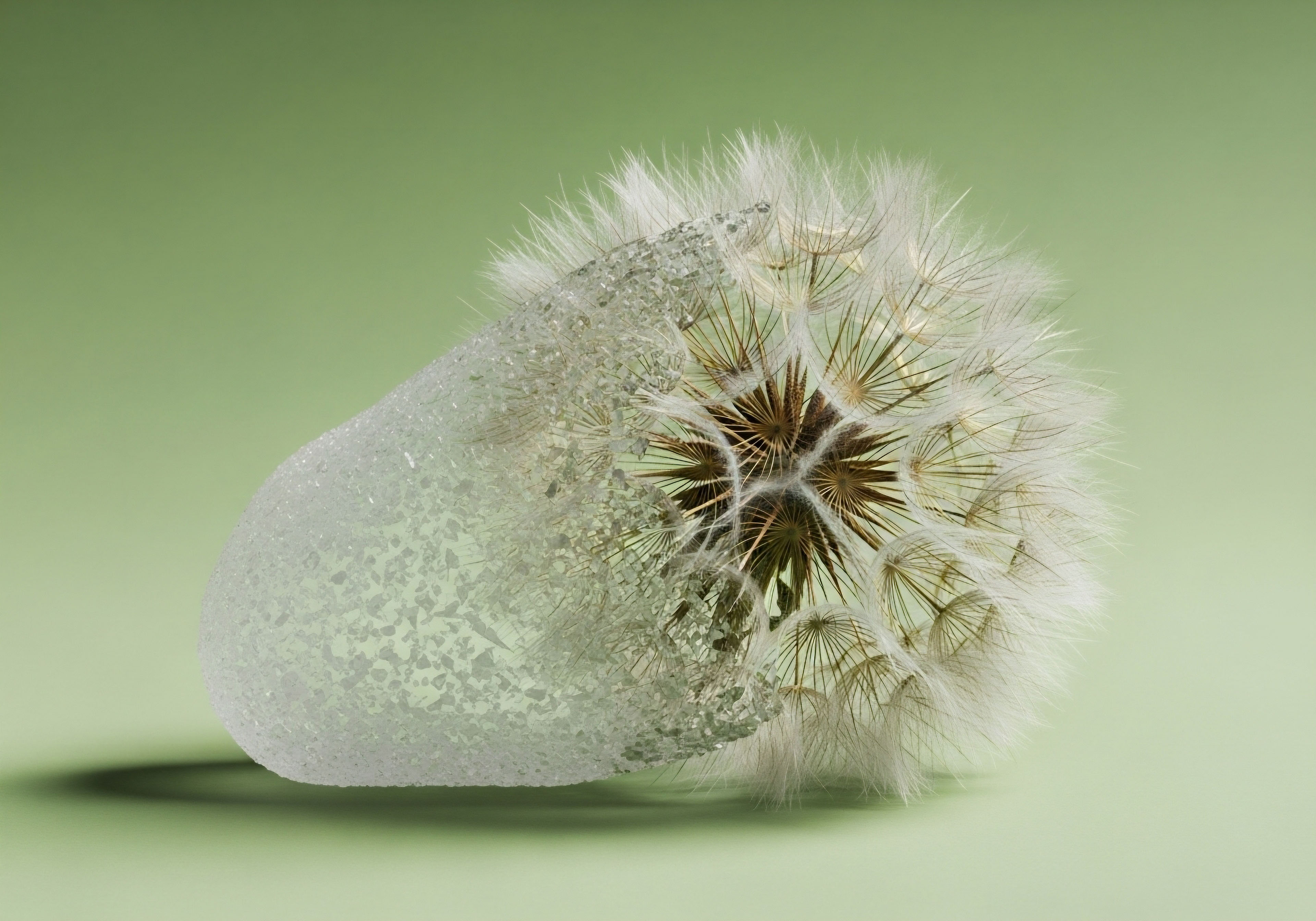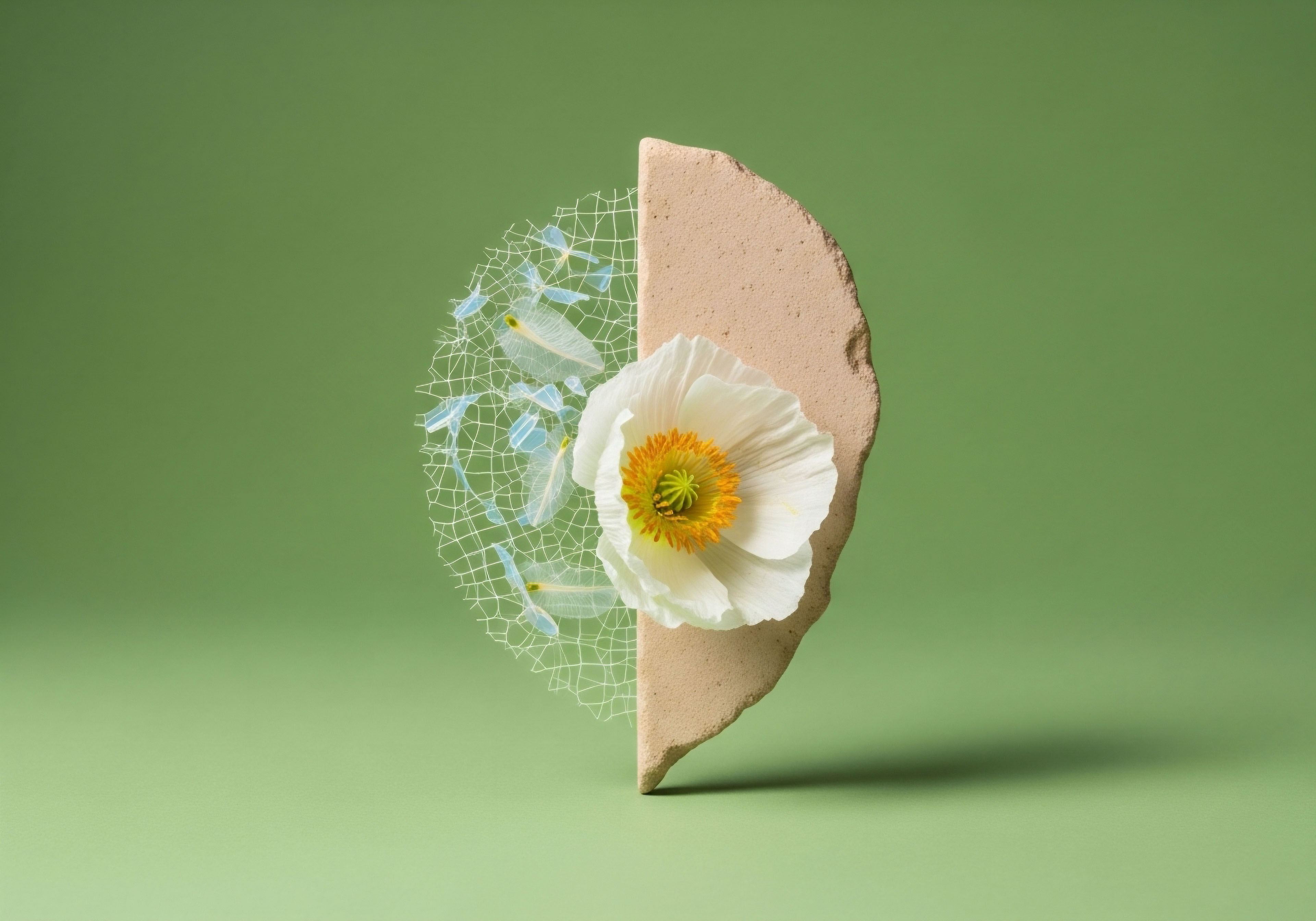

Fundamentals
The aspiration to create a family is a deeply personal and biological imperative. When you confront challenges in this area, it can feel as though your own body is working against a fundamental part of who you are.
The experience of infertility is often a silent one, a journey of tests and uncertainty that can leave you feeling isolated from the natural rhythms of life. Your body is a complex, interconnected system of communication, and at the heart of reproductive health lies a precise and elegant dialogue between the brain and the gonads.
This dialogue is governed by the Hypothalamic-Pituitary-Gonadal (HPG) axis, the primary command and control center for your entire reproductive system. Understanding its function is the first step toward understanding your own story and reclaiming a sense of agency over your health.
Imagine the hypothalamus, a small region at the base of your brain, as the system’s conductor. Its role is to send out a very specific, rhythmic signal to the rest of the orchestra. This signal is a hormone called Gonadotropin-Releasing Hormone, or GnRH.
The hypothalamus releases GnRH in carefully timed pulses, a biological cadence that is absolutely essential for proper reproductive function. This pulsatile signal travels a short distance to the pituitary gland, the orchestra’s lead violinist. The pituitary, upon receiving this rhythmic cue, responds by producing its own two critical hormones ∞ Luteinizing Hormone (LH) and Follicle-Stimulating Hormone (FSH).
These hormones then travel through the bloodstream to the gonads ∞ the testes in men and the ovaries in women ∞ which are the final instrumental sections. LH and FSH instruct the gonads to perform their essential duties ∞ producing sex hormones like testosterone and estrogen, and maturing sperm or eggs.
The body’s reproductive capability relies on a rhythmic hormonal conversation originating in the brain, known as the Hypothalamic-Pituitary-Gonadal axis.
In certain conditions, such as congenital hypogonadotropic hypogonadism (CHH), the conductor is silent. The hypothalamus fails to produce these critical GnRH pulses. Without its rhythmic cue, the entire hormonal orchestra remains dormant. The pituitary does not produce LH and FSH, and consequently, the gonads are never instructed to mature and function.
This results in a state of hormonal silence that leads to infertility. The system is intact, yet its activation signal is missing. Pulsatile gonadorelin therapy directly addresses this foundational issue. It is a form of biological restoration, a way of reintroducing the missing rhythm. The therapy provides the body with the very signal it is unable to create for itself, seeking to awaken the dormant potential within your own physiological systems.

The Principle of Biological Mimicry
Pulsatile gonadorelin therapy operates on a principle of profound biological respect. It works by mimicking the body’s natural processes with high fidelity. The treatment involves a small, portable pump that is programmed to deliver a precise dose of gonadorelin, a synthetic form of GnRH, subcutaneously at regular intervals, typically every 90 to 120 minutes.
This method replicates the natural, pulsatile secretion pattern of the hypothalamus. By re-establishing this foundational rhythm, the therapy aims to systematically reactivate the entire HPG axis. The goal is to gently and persistently prompt your body to resume a conversation that has been interrupted.
It is a process of reminding your pituitary gland how to respond and, in turn, how to guide your gonads toward mature function. This approach validates the inherent capability of your own body, providing the missing stimulus required to unlock its intended physiological purpose.


Intermediate
Advancing from the foundational understanding of the HPG axis, we can examine the clinical application and the direct biological consequences of pulsatile gonadorelin therapy. This treatment protocol is a precise, calculated intervention designed to substitute for a specific physiological deficiency.
The administration via a portable infusion pump is a critical component of its success, as the intermittent, rhythmic delivery of gonadorelin is what stimulates the pituitary gonadotrope cells correctly. A continuous, non-pulsatile delivery of GnRH would, paradoxically, lead to the shutdown of the system, a mechanism that is clinically used for other purposes.
The pulsatile nature is everything. Upon initiation of therapy, the synthetic GnRH begins its work, binding to its specific receptors on the pituitary gland. This binding event triggers a cascade of intracellular signaling that awakens the gonadotrope cells from their quiescent state.
The immediate biochemical response is the synthesis and release of LH and FSH into the bloodstream. Clinicians monitor this response through regular blood tests, observing the gradual rise of these gonadotropins from their previously low or undetectable levels. This rise is a direct indicator that the pituitary is responding to the reintroduced signal.
The newly released LH and FSH then travel to the gonads, carrying the brain’s instructions. In men, LH stimulates the Leydig cells in the testes to produce testosterone, while FSH acts on the Sertoli cells, which are essential for nurturing the development of sperm in a process called spermatogenesis.
In women, FSH stimulates the growth of ovarian follicles, each containing an egg, while the mid-cycle surge of LH is the trigger for ovulation. The long-term success of the therapy hinges on this carefully re-established chain of command, moving from the pump, to the pituitary, to the gonads.
Successful therapy is marked by a measured increase in pituitary hormones LH and FSH, which directly translates to renewed gonadal activity and function.

Comparing Therapeutic Approaches for Male Fertility
When the goal is inducing spermatogenesis in men with CHH, clinicians have two primary therapeutic avenues ∞ pulsatile GnRH therapy and combined gonadotropin therapy (using injections of human chorionic gonadotropin, hCG, and human menopausal gonadotropin, hMG). While both can be effective, they work through different mechanisms and can produce different long-term outcomes.
Pulsatile GnRH therapy is considered more physiological because it activates the body’s own pituitary, resulting in the production of its own LH and FSH in a natural ratio. In contrast, hCG/hMG therapy bypasses the pituitary entirely, providing external hormones that directly stimulate the testes. HCG mimics the action of LH, while hMG provides FSH activity.
Clinical studies comparing these two modalities reveal important distinctions in their effects. While both approaches can successfully induce sperm production, pulsatile GnRH therapy often achieves this outcome more quickly. A significant long-term benefit observed with pulsatile GnRH is its superior impact on testicular growth.
The testes of men undergoing this therapy tend to reach a larger final volume compared to those on hCG/hMG therapy. This is biologically significant because testicular volume is largely composed of seminiferous tubules, the site of sperm production. A larger testicular volume suggests a more robust and healthy development of the machinery required for sustained spermatogenesis.
This difference is attributed to the more balanced and natural stimulation provided by the body’s own LH and FSH, prompted by the GnRH pump.
The following table provides a comparative overview based on clinical findings:
| Feature | Pulsatile Gonadorelin (GnRH) Therapy | Combined Gonadotropin (hCG/hMG) Therapy |
|---|---|---|
| Mechanism of Action | Stimulates the body’s own pituitary to produce LH and FSH. Considered more physiological. | Bypasses the pituitary to directly stimulate the gonads with external hormones. |
| Time to Spermatogenesis | Generally shorter. Studies show a faster mean time to the appearance of sperm. | Can be longer. The median duration of treatment is similar, but the mean time can be extended. |
| Testicular Volume Outcome | Leads to greater increases in testicular volume, a key marker of gonadal health. | Results in less significant testicular growth compared to pulsatile GnRH. |
| Spermatogenesis Success Rate | High success rates, often cited between 75-82%. Effective even in patients who previously failed gonadotropin therapy. | Similar success rates in treatment-naive patients (around 76%). |
| Administration | Requires a portable infusion pump for continuous, pulsatile subcutaneous delivery. | Involves regular self-administered injections, typically multiple times per week. |

What Are the Procedural Realities of Pump Therapy?
Living with a GnRH pump requires a period of adaptation. The device, which is small enough to be worn discreetly, is connected to a thin cannula inserted under the skin, usually on the abdomen. The site needs to be changed every few days to maintain hygiene and ensure proper absorption.
Patients learn to manage the device, fill its reservoir with gonadorelin, and respond to its alarms. While this represents a significant daily commitment, for many it becomes a manageable routine. The process is a constant, tangible connection to the act of restoring their body’s function. The psychological component of this therapy is substantial; it is an active, daily participation in one’s own path to fertility, a direct investment in reawakening a dormant biological system.


Academic
A deep analysis of the long-term outcomes of pulsatile gonadorelin therapy requires a perspective rooted in systems endocrinology. The therapy’s primary success is the re-establishment of the HPG axis, but its full impact extends to the overall health and maturation of the gonadal microenvironment.
The superiority of pulsatile GnRH in promoting testicular volume is a critical academic point. Testicular volume is a surrogate marker for the proliferation of Sertoli cells and the development of the seminiferous tubules.
The more physiological ratio of FSH to LH produced by the patient’s own pituitary under GnRH stimulation appears to be more effective at inducing this foundational growth than the direct, external administration of hCG and hMG. This suggests that the long-term benefit is a more robust and potentially more resilient spermatogenic capacity. A larger, healthier testicular architecture may be better equipped to sustain sperm production over time.
Furthermore, the efficacy of pulsatile GnRH in patients who have previously failed to respond to at least one year of hCG/hMG therapy is a compelling area of study. Research has shown that a significant percentage of these “poor responders,” approximately 60.7%, can successfully achieve spermatogenesis after switching to pulsatile GnRH.
This finding implies that the mechanism of failure in these individuals may lie at the pituitary level or that their gonads require the specific priming that only endogenous, pulsatile gonadotropin secretion can provide. It challenges the idea that a lack of response to direct stimulation is an irreversible gonadal failure.
Instead, it points to the sophisticated interplay between the pituitary and the testes, a relationship that is best restored by addressing the apex of the axis with GnRH. The GnRH molecule itself may also have direct receptors and actions within the testes, further contributing to its efficacy beyond simple gonadotropin release.

Long Term Endocrine Function and Fertility Potential
The central question regarding long-term outcomes is the sustainability of fertility. For individuals with congenital hypogonadotropic hypogonadism, the underlying deficiency in hypothalamic GnRH production is permanent. Therefore, pulsatile gonadorelin therapy is a restorative treatment, not a cure. Once the therapy is discontinued, the HPG axis will, in most CHH cases, revert to its quiescent state.
LH, FSH, and testosterone levels will decline, and spermatogenesis will cease. Consequently, for those desiring ongoing fertility or the maintenance of normal testosterone levels, therapy may need to be cyclical or continuous. Some protocols may involve using pulsatile GnRH to initiate spermatogenesis and achieve a pregnancy, after which the patient might transition to testosterone replacement therapy for maintenance of secondary sexual characteristics, with the understanding that GnRH therapy can be resumed for future fertility attempts.
The long-term health of children conceived through this method is another crucial consideration. Current data, gathered over several decades of use, has not indicated any increase in congenital abnormalities or adverse health outcomes in offspring. The process relies on stimulating the body to produce its own gametes through a natural hormonal cascade, which is likely why the outcomes are positive.
The sperm or egg that is ultimately produced is a product of the individual’s own restored gonadal function, not a direct product of the drug itself. The therapy simply opens the biological pathways for this to occur.
The sustained benefit of pulsatile GnRH therapy is the establishment of a healthy gonadal architecture, which may support more robust fertility during treatment periods.
The table below summarizes key long-term outcome data derived from clinical studies on male patients with CHH.
| Outcome Parameter | Clinical Findings and Long-Term Implications |
|---|---|
| Spermatogenesis Induction | Success rates are high, ranging from 60% in prior non-responders to over 80% in treatment-naive patients. The median time to achieve spermatogenesis is approximately 12 months. |
| Testicular Volume | Pulsatile GnRH therapy consistently produces superior testicular growth compared to hCG/hMG. Mean final volumes can be more than double those achieved with direct gonadotropin stimulation. This is a key long-term structural benefit. |
| Hormonal Profile | Effectively normalizes LH, FSH, and testosterone levels during treatment, mimicking a physiological state. These levels decline upon cessation of therapy in patients with permanent CHH. |
| Fertility Sustainability | Fertility is dependent on active treatment. The therapy can be paused and successfully resumed for subsequent pregnancies, indicating a durable responsiveness of the reawakened HPG axis. |
| Predictive Factors for Success | A higher baseline testicular volume before treatment is a positive predictor of success and higher sperm concentrations at the end of treatment. The pituitary’s response to an initial GnRH stimulation test can also be predictive. |

How Does This Inform Future Endocrine Health Management?
The experience with pulsatile GnRH therapy provides profound insights into the plasticity and responsiveness of the endocrine system. It underscores that even in cases of congenital absence of a key signaling hormone, the downstream components of the axis can remain viable and responsive for decades.
This has implications for how we view hormonal health in general. It suggests that many endocrine dysfunctions may be viewed as communication breakdowns, where restoring the correct signal, rhythm, and timing can unlock the body’s innate capacity for self-regulation and function. The success of this therapy reinforces a systems-based approach to endocrinology, one that prioritizes understanding and restoring the entire communication axis over simply replacing the final hormonal product.
- System Recalibration The primary long-term outcome is the functional recalibration of the HPG axis for the duration of the therapy. It demonstrates the axis’s retained ability to function when properly stimulated.
- Gonadal Maturation A crucial benefit is the structural and functional maturation of the gonads. The significant increase in testicular volume is not merely cosmetic; it represents the development of a more robust platform for gametogenesis.
- Cyclical Fertility The therapy establishes the potential for cyclical fertility. Patients can undergo treatment to achieve pregnancy, pause, and then successfully restart the protocol years later, demonstrating the durability of the response.

References
- Liu, Z. et al. “Efficacy and safety of pulsatile gonadotropin-releasing hormone therapy in patients with congenital hypogonadotropic hypogonadism ∞ a multicentre clinical study.” Annals of Translational Medicine, vol. 9, no. 13, 2021, p. 1065.
- Wang, C. et al. “Comparison of outcomes between pulsatile gonadotropin releasing hormone and combined gonadotropin therapy of spermatogenesis in patients with congenital hypogonadotropic hypogonadism.” Andrologia, vol. 54, no. 3, 2022, e14339.
- Mao, J. et al. “Pulsatile gonadotropin releasing hormone therapy for spermatogenesis in congenital hypogonadotropic hypogonadism patients who had poor response to combined gonadotropin therapy.” Endocrine, vol. 58, no. 1, 2017, pp. 120-126.
- “Gonadotropin-releasing hormone.” Wikipedia, Wikimedia Foundation, last edited 20 May 2024.
- Martin, K.A. and Corrine K. Welt. “Induction of puberty with GnRH.” UpToDate, accessed June 2024.
- Bouvattier, C. et al. “Management of gonadotropin-releasing hormone (GnRH) deficiency in infancy and childhood.” Annales d’Endocrinologie, vol. 72, no. 2, 2011, pp. 90-93.
- Hoffman, A.R. and N.A. Tritos. “Treatment of hypogonadism in men with gonadotropin-releasing hormone deficiency.” Endocrinology and Metabolism Clinics of North America, vol. 38, no. 4, 2009, pp. 719-733.

Reflection

Your Path to Biological Understanding
The information presented here offers a window into the intricate mechanics of your own body. It details a clinical pathway that uses a deep understanding of human physiology to restore a fundamental biological process. This knowledge is a tool. It allows you to move from a place of uncertainty to one of informed inquiry.
Your personal health narrative is unique, and the data points and clinical outcomes are population-level observations. The next step in your journey involves translating this broader scientific understanding into a personalized context. Consider how these systems and processes relate to your own experiences and health goals.
The path forward is one of partnership, combining your lived experience with clinical expertise to map out a strategy that aligns with your body’s specific needs. You are the foremost expert on yourself; this clinical knowledge serves to empower your expertise.



